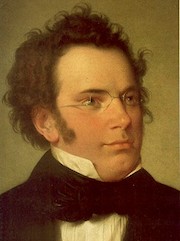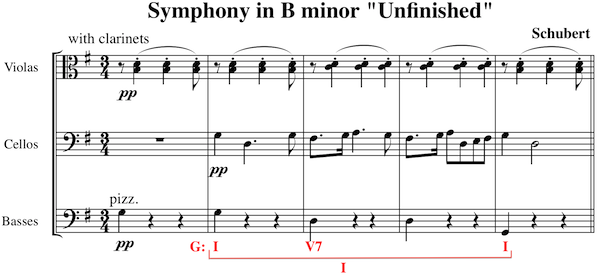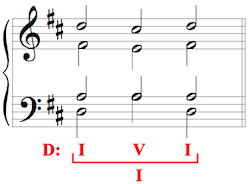
HARMONIC EXPANSIONS
CHAPTER 1: EXPANDING THE TONIC TRIAD; THE FUNDAMENTAL HARMONIC PROGRESSION
1.3 The fundamental harmonic progression and the birth of the dominant
 |
 |
 |
 Franz Schubert (1797 - 1828), Austrian composer best known for his symphonies and lieder (German art songs). |
 |
| This excerpt from Schubert's "Unfinished" Symphony has chords whose root movement is I V I. On the previous page, adding scale degrees 2 and 7 as lower neighbors and raising the bass a fifth within a tonic triad also produced a I V I progression. See below. | |

|
The illustration to the left shows the last measure in the series of expansions at the end of page 1.2. On a very basic level this progression--root position I - V - I with scale degree 1 in the soprano of the final chord--can represent a whole piece of music, and when it does so it is called the fundamental harmonic progression The German music theorist, Heinrich Schenker who coined this term, also stipulated that the Fundamental Harmonic Progression have scale degrees 3, 2 and 1 in the soprano, but this will not necessarily be the case on these pages. The bracket within the Roman numerals shows that the fundamental harmonic progression is an expansion (or an "elaboration," "prolongation" or "unfolding") of the tonic triad. Schenker named this tonic triad, the one represented by the Roman numeral I below the bracket, the "Urklang," a German word which has been translated as the "chord of nature" and which will be referred to here as the primordial tonic. The illustration to the left also shows that the insertion of two lower neighbors as described on page 1.2 automatically results in Common Tone Stepwise voice leading as described in Chapter 15 of the Fundamentals worksheets on this site. The tenor keeps the common tone while the soprano and alto move by step. |
|
PLAY and LISTEN FOR two I V I progressions in Beethoven's "Für Elise" (though these are not fundamental harmonic progressions). SING the roots of the chords as you hear them played back. |
|
 |
Your turn! Write I V I progressions in four parts with paper and pencil, using the last illustration on this page as a model. 1. DOWNLOAD pdf file 01.3 to print and write your progressions on. 2. ENTER your part writing on the Harmonic Expansions 1.3 page in Noteflight. |
 |
 |
 |
 |
Comments? Click here. |



